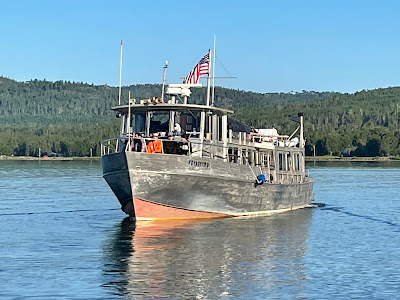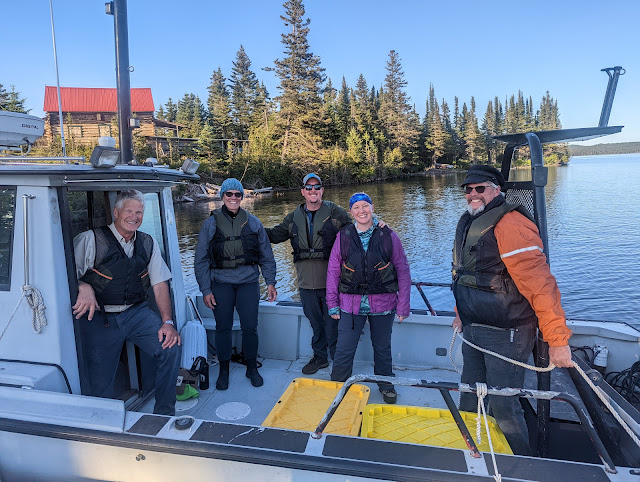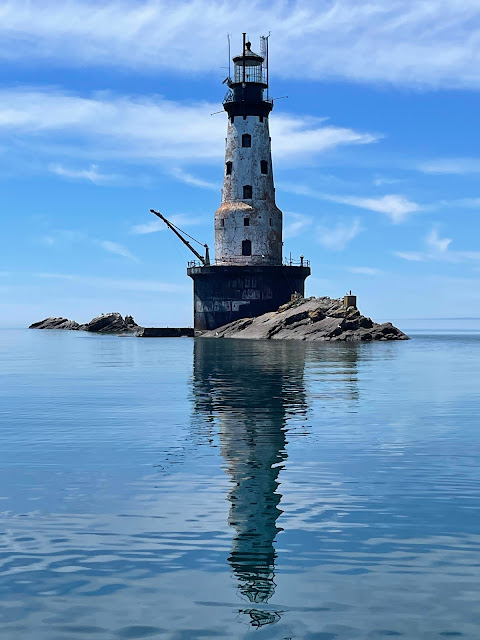A New Crew for Week Four
Mary’s name was called out by the captain of the Voyager for boarding. I remember the name from the Volunteer Schedule, so I could identify at least one of my fellow Rock of Ages Lighthouse Preservation Society volunteers. My name was called soon after, so I followed her to the engine room, where she sat on one of the engines. Rachael, our crew lead on week one, had told me that if it’s cold on the lake during a crossing, you could find warmth by sitting on the metal enclosure covering the Voyager engine.
“Hello, Mary,” I introduced myself, “it seems like you’ve been on this voyage as a Rock of Ages volunteer before.” She shared that she had volunteered on the light several times. It turns out she is a board member of the ROALPS, which we never let her forget as we accused her of being an “undercover Boss.” In answering my question, that I would ask of every volunteer I would meet, she began to share how far things had come since she first started working in the lighthouse. The more she shared, the more excited she became anticipating what could be accomplished over the next week, until the engine noise overwhelmed my ability to hear her. This process would be repeated with other volunteers in the coming week.
“Other volunteers are on board, aren’t they,” I asked as the Voyager throttled down on arrival at Windigo.
“Sure, that lady is also a board member,” she replied, pointing to Carne across room with her husband, Tim. “They’re going to work at the cabin this week, along with their friend Kate, hoping for a opportunity to visit the lighthouse - a first for Tim and Kate. They’re all important donors to the cause.”
 |
| Week Four Crew - plus a ferry boat captain... |
Arriving at the dock, Mark, the boat operator I was relieving, and Dirk, the crew leader for the past week, welcomed us to Windigo. All the arriving passengers stood on the dock for the required NPS Ranger presentation on the rules of the road and recommendations for dealing in the wilderness. Mark whisked me off to the side for some quick discussion of what needed to be addressed on the boat. He had very little time to transfer his knowledge and the boat log before he would be boarding the same boat we came in on for the trip to Rock Harbor, where his week-long hiking adventure back to Windigo would begin.
When the passengers were released, our crew gathered in the nearby pavilion to fill out volunteer registration and release forms required by the Park Service. Joining us there to fill out the lighthouse work crew were Kyle and Alisha, who had arrived a few days early to spend three days hiking, paddling, and exploring the area. Once finished everyone was free to look around, or to join Dirk’s interpretive presentation, at Park Service request, on the lighthouse and our restoration efforts. Of course, we all gathered there to hear his historical perspective.
All I could think about during all of this was what I was going to do with a boat I’d never operated. How was I going to avoid colliding with the dock, or putting passengers on their bums when applying the power of those 300 horses mounted on the back. And how was I going to instill confidence in my crew mates so that they would have the trust to get back on the boat for the trip to the lighthouse.
Fortunately, the Rock Hopper is equipped with very nice hydraulic and programmable controls, along with plenty of navigational instrumentation, to help me seem competent from the start. Jeff Sivertson, as boat operator in the past, had programmed a whole series of waypoints into the chart plotter so I could simply follow the breadcrumbs all the way to Barnum Island, avoiding any reefs or rocks along the way.
Arriving at the cabin, Dirk and I discussed the possibility of moving on to the lighthouse yet that day. It seemed unlikely at that moment, with wind creating enough wave action to suggest that a first-time dock approach by a green skipper might come with too much risk. However, I knew from my past experience that it was common for the lake to lay down in late afternoon as the wind diminished toward dusk. We were also motivated by the thought of eight of us trying to find some sleeping accommodations in a cabin built for a comfortable six. None of the lighthouse crew unpacked in anticipation of the possibility.
“I came across this opportunity by stopping by Dave’s booth at the Gales of November,” Dirk said in response to my proverbial question. “My regular job is in maintaining and restoring a well known and historic building in the Twin Cities, so this seemed like a good fit with my skills. My friends think I’m crazy to spend my vacation time doing the kinds of things I do every day, but I really like it. It feels different when you’re doing it in a historic lighthouse that few have a chance to see or visit.”
Another skill he failed to mention at the time was that of cell phone photography. I didn’t realize that was a thing, but the pictures he takes and finishes with his phone are spectacular. He is an unbelievable visual documentarian of the area during his limited free time on the Rock and on Barnum Island. You don’t notice it much, but he’s always pointing the phone at something that translates into a unreproducible shot. So much so that I’ve decide to include his photos (with his permission) almost exclusively in this blog (hence the watermarks). I just can’t come close to capturing the atmosphere and feel of the place like he can.
Alisha and Kyle left their four children with parents for the week to volunteer for work on the lighthouse, and to leverage a unique connection. Alisha’s father was a “Coastie” who worked on the light in the early 1970’s. Her perspective through his eyes enlightened all of us. Later in the week, he would join the crew at the light in a visit by boat to explain more details. I wish I could have been a mouse in the corner for that conversation.
*****
The crew spent the day taking inventory of the food, neatly packed in marked boxes or totes. The first-timers toured the island as Dirk shared what history he had learned from the local islanders in past visits. He always prefaced each story with, “this is what I heard, but each person I’ve talked with has their own version of it.” Veterans spent their time reacquainting themselves, assessing any changes in conditions of the cabin, taking note of projects that could be done during the week by those not going to the lighthouse.
That evening, the wind did diminish, and we were able to make the trip to the light. There was still a bit of a swell that rocked the boat slightly as we approached what is left of the old concrete dock. Ice and waves sure have gotten the better of it. Just off the end of the dock 1-1/4” rebar is exposed and twisted in the water to discourage any thought of a simply pulling along side. Instead, the approach needs to be at a sharp angle and a quick adjustment to bring in the stern, but avoid forward momentum that would cause the boat to run into the 90 degree concrete wall that anchors to the rock. Not a lot of room for the Rock Hopper, or for error. It was all hands on the lines to keep the Rock Hopper in position while backpacks and bags were tossed up two feet on to the dock. As soon as everyone and everything was off, we backed our way out through the swells and headed back to Barnum Island, leaving the lighthouse crew to get settled for the night. Fortunately Dirk had been there for a week already, so accommodations could be navigated relatively quickly.
The rest of us returned in anticipation of a windier day with possible rain on Sunday, glad that the crew could get started on the core objectives of our collective ambition. Either way, it was going to be a good day on the Rock of Ages, and a good day on Barnum Island, we were sure.









Comments
Post a Comment